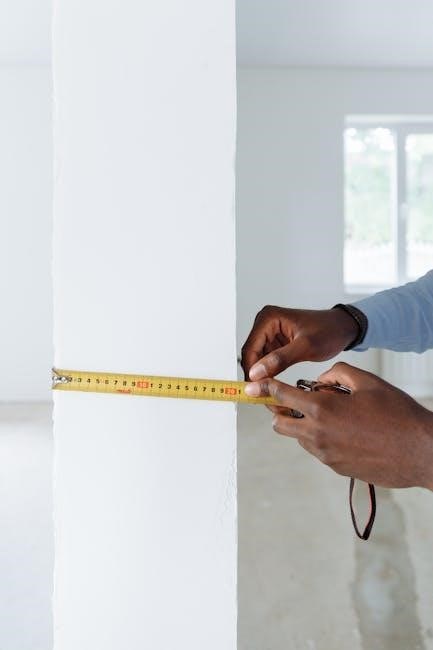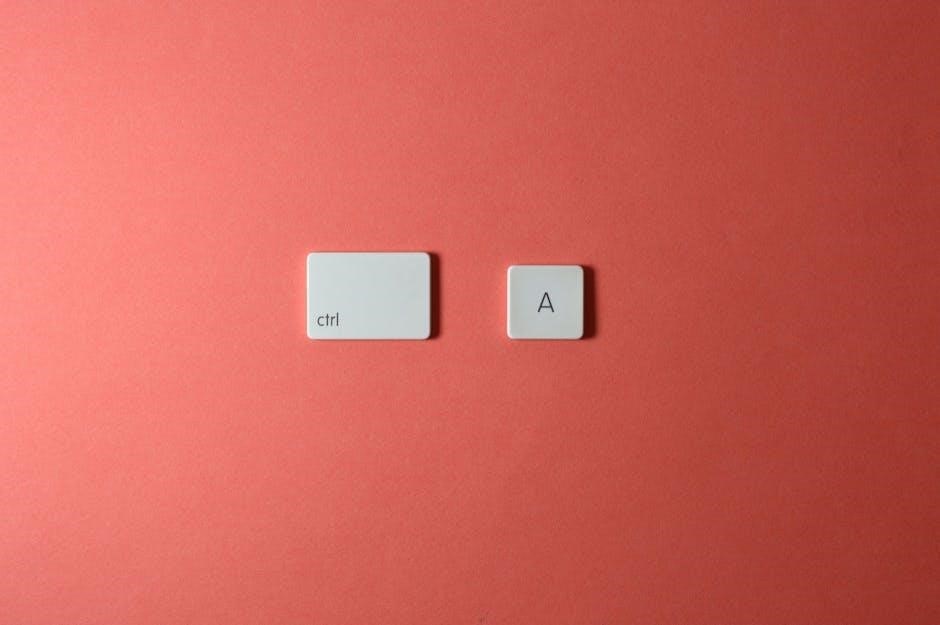The WW Scale is a precision bathroom scale designed to track weight, body fat, and BMI, offering a comprehensive tool for weight management. It seamlessly syncs with the Weight Watchers app, providing a holistic approach to health tracking. The user manual, available in PDF format, guides users through setup, features, and maintenance, ensuring optimal use of the scale’s advanced capabilities.
Unboxing and Initial Setup
Upon unboxing, ensure the WW Scale is complete with the scale, user manual, and batteries. Place it on a flat, stable surface and insert batteries as per the manual. Follow the quick-start guide for initial setup and calibration before first use.

2.1 What’s Included in the Box?
When you unbox your WW Scale, you’ll find the scale itself, a user manual, and batteries to power it. The user manual is detailed, covering setup, calibration, and troubleshooting. It’s available in PDF format online for easy access. Additionally, some models include a quick-start guide to help you get started quickly. The scale is designed to be user-friendly, with clear instructions to ensure proper installation and use. Make sure to check all items before discarding packaging to avoid missing any components. The manual also provides information on maintenance and care to extend the life of your scale. If you have a Weight Watchers subscription, the manual will guide you on syncing your scale with the app. Always refer to the manual for specific instructions tailored to your model. This ensures you get the most out of your WW Scale and its features.

2.2 Step-by-Step Setup Guide
Setting up your WW Scale is straightforward and quick. Start by carefully unpacking the scale and ensuring all components are included. Insert the provided batteries into the scale, following the polarity markings to avoid errors. Place the scale on a flat, stable surface, such as a bathroom floor, to ensure accurate measurements. Turn on the scale by stepping on it gently or pressing the power button, if available. The scale will initialize and display a calibration message. Follow the on-screen instructions to complete the calibration process, which ensures precise weight measurements. Once calibrated, the scale is ready for use. For users with a Weight Watchers subscription, refer to the user manual to sync the scale with the Weight Watchers app. This allows seamless tracking of your weight data. If you encounter any issues, consult the troubleshooting section in the manual. Proper setup is essential for accurate results and optimal performance of your WW Scale.

Understanding the Features of the WW Scale
The WW Scale offers advanced features like weight tracking, body fat analysis, and BMI calculation, providing a comprehensive health overview. It supports multiple user profiles and syncs with the Weight Watchers app for seamless data tracking. The scale is designed for accuracy and durability, making it a reliable tool for weight management. Refer to the user manual for detailed instructions on utilizing these features effectively.

3.1 Types of WW Scales Available
Weight Watchers offers a variety of scales designed to meet different user needs. The WW52C and WW54C models are popular bathroom scales that provide accurate weight measurements. The WW54C additionally includes body fat and BMI tracking. For advanced users, the Weight Watchers Precision Body Weight Analysis Scale (Argos Product 832/1846) offers detailed body composition analysis, including body fat percentage and muscle mass. Some models, like the WW66, also feature customizable settings and multi-user support; These scales are designed to integrate seamlessly with the Weight Watchers app, allowing users to track their progress and set health goals. Refer to the user manual for specific details on each model’s features and capabilities. By choosing the right WW scale, users can enhance their weight management journey with precise and reliable data.
3.2 Overview of the Scale Display
The WW Scale features a clear and user-friendly display designed to provide essential information at a glance. Most models come with a large LCD screen that shows weight in pounds or kilograms, depending on the user’s preference. Higher-end models, such as the Weight Watchers Precision Body Weight Analysis Scale, also display additional metrics like body fat percentage and BMI. The display is backlit for better visibility, even in low-light conditions. Some scales include a progress bar or graphical representations to help users track their goals. The interface is intuitive, with clear numerical readings and minimal clutter. For users who prefer simplicity, basic models like the WW52C focus solely on weight measurement, ensuring ease of use. The display automatically turns off after a few seconds to conserve battery life. Refer to the user manual for specific details on how to adjust settings or customize the display based on your model. This feature ensures a seamless and efficient user experience.
3.3 Measurement Units and Accuracy
The WW Scale offers versatile measurement units, including pounds, kilograms, and stones, catering to a wide range of user preferences. The scale is designed for high accuracy, typically measuring weight in 0.1-pound or 0.1-kilogram increments. Advanced models, such as the Weight Watchers Precision Body Weight Analysis Scale, also provide body fat percentage measurements, ensuring comprehensive health tracking. The accuracy of the scale is enhanced by its strain gauge technology, which delivers reliable and consistent readings. For optimal performance, the scale should be placed on a hard, flat surface and calibrated regularly. Users can switch between units via the menu settings, as outlined in the instruction manual. The WW Scale is known for its precision, making it a trusted tool for weight management. Regular calibration ensures that measurements remain accurate over time. By following the guidelines in the user manual, users can maintain the scale’s performance and reliability. This attention to detail makes the WW Scale a valuable asset for anyone monitoring their weight and body composition.

Calibrating the WW Scale
Calibrating the WW Scale ensures accurate measurements. Place the scale on a hard, flat surface and press the calibration button until “0.0” appears. Follow the manual’s steps to complete the process for precise weight tracking.
4.1 How to Calibrate the Scale
Calibrating the WW Scale is essential for accurate weight measurements. Begin by placing the scale on a flat, hard surface. Ensure the scale is turned on and press the calibration button until the display shows “0.0.” This indicates the scale is resetting to its zero point. Next, step off the scale and allow it to stabilize. The calibration process is complete when the display shows your weight accurately. For optimal accuracy, avoid placing the scale on carpet or soft surfaces, as this can affect balance. If the scale is moved, recalibrate it to ensure precise measurements. Refer to the user manual for detailed steps, as different models may have slightly varying calibration procedures. Proper calibration ensures reliable data, making it a crucial step in maintaining the scale’s performance and accuracy for your weight management journey.
Using the WW Scale for Weight Measurement
Step on the scale with bare feet to ensure accurate readings. Turn it on and wait for the display to stabilize. The scale will automatically measure your weight, providing precise results. Ensure the surface is flat and stable for optimal accuracy.
5.1 Advanced Features: Body Fat and BMI
The WW Scale offers advanced features beyond basic weight measurement, including body fat percentage and BMI calculation. These features provide a more comprehensive understanding of your health and progress. To use these features, ensure the scale is calibrated correctly and placed on a flat, stable surface.
Body fat measurement is taken using bioelectrical impedance analysis (BIA), which sends a small electrical current through the body. This provides an estimate of body composition, helping you track changes in muscle and fat mass over time. BMI (Body Mass Index) is calculated automatically using your weight and height, offering a quick assessment of whether your weight is in a healthy range.
- Body fat percentage helps monitor muscle and fat changes.
- BMI provides a quick health assessment based on weight and height.
- These features sync with the Weight Watchers app for detailed tracking.
Refer to the user manual for troubleshooting and accurate measurements. These advanced features make the WW Scale a valuable tool for holistic health monitoring. Always follow the manual’s guidelines for best results.
Syncing the WW Scale with the Weight Watchers App

The WW Scale seamlessly connects to the Weight Watchers app, allowing automatic syncing of your weight, body fat, and BMI data. This integration provides real-time tracking and personalized insights to support your weight management journey. Refer to the user manual for detailed syncing instructions and troubleshooting tips.
6.1 Benefits of App Syncing
Syncing your WW Scale with the Weight Watchers app offers numerous benefits, enhancing your weight management journey. Automatic data tracking eliminates manual entry, ensuring accuracy and convenience. The app provides real-time insights, allowing you to monitor progress toward your goals seamlessly. With personalized recommendations, you can make informed decisions to achieve a healthier lifestyle. Additionally, the app enables you to track body fat and BMI, offering a comprehensive view of your health metrics. Syncing also allows access to community support, where you can share achievements and stay motivated. The integration of weight data with your Weight Watchers account streamlines your program experience, making it easier to stay on track. Regular updates and new features ensure the app remains a valuable tool for long-term success; By leveraging these benefits, you can maximize the potential of your WW Scale and app combination, fostering a more effective and engaging weight management routine.

Maintenance and Troubleshooting
Regularly clean the WW Scale with a soft cloth and avoid harsh chemicals. Check for software updates to ensure optimal performance. If issues arise, reset the scale or refer to the troubleshooting guide in the user manual for solutions.
7.1 Cleaning and Caring for Your Scale
Proper cleaning and care are essential to maintain the accuracy and longevity of your WW Scale. Use a soft, dry cloth to wipe the scale’s surface, avoiding harsh chemicals or abrasive materials that could damage the finish. For stubborn stains, lightly dampen the cloth with water, but ensure the scale is completely dry before use. Avoid exposing the scale to extreme temperatures or moisture, as this may affect its internal components. Regularly check the scale’s feet for dust or debris, as this can impact weight accuracy. For optimal performance, recalibrate the scale periodically, following the instructions in the user manual. Store the scale on a flat, stable surface when not in use to prevent damage. By following these care tips, you can ensure your WW Scale remains reliable and accurate for years to come.
User Manual and Additional Resources
The WW Scale comes with a comprehensive user manual, available in PDF format, which provides detailed instructions for setup, usage, and troubleshooting. This manual is designed to help users maximize the scale’s features and ensure accurate measurements. Additional resources, such as FAQs and customer support, are also accessible online to address any questions or concerns. The manual includes step-by-step guides for calibrating the scale, syncing it with the Weight Watchers app, and understanding advanced features like body fat and BMI analysis. For further assistance, users can visit the official Weight Watchers website or contact their support team. These resources ensure a smooth and effective experience with the WW Scale, helping users achieve their weight management goals effortlessly.

Frequently Asked Questions
Here are some common questions about the WW Scale and its use:
- Do I need the instruction manual to set up the scale? Yes, the manual provides essential steps for calibration and syncing with the Weight Watchers app.
- How do I sync the scale with my Weight Watchers app? Follow the manual’s instructions to connect via Bluetooth or Wi-Fi for seamless data transfer.
- Is the scale accurate for body fat and BMI measurements? Yes, the WW Scale uses advanced technology to ensure precise readings, but accuracy depends on proper calibration.
- Can I use the scale without a Weight Watchers subscription? Absolutely, though syncing with the app enhances tracking and weight management.
- Where can I find additional support if I have issues? Visit the official Weight Watchers website or contact customer support for assistance.

These FAQs address common concerns and help users make the most of their WW Scale experience.
The WW Scale is a powerful tool designed to support your weight management journey, offering precise measurements and advanced features like body fat and BMI tracking. By following the instruction manual, users can easily set up and calibrate the scale, ensuring accurate readings. The ability to sync with the Weight Watchers app enhances tracking, providing a comprehensive view of your progress. Whether you’re a Weight Watchers subscriber or not, the scale offers a user-friendly experience tailored to your health goals. Regular maintenance and proper care, as outlined in the manual, will extend the life of your scale. With its sleek design and robust features, the WW Scale is an excellent choice for anyone looking to monitor their weight and maintain a healthy lifestyle. By investing in this scale, you take a significant step toward achieving and sustaining your wellness objectives.
